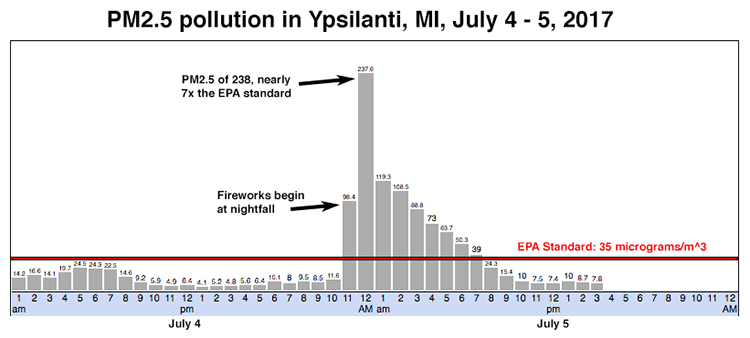| Above: Fireworks fired from barges on the Detroit River as part of the International Freedom Festival light up the Detroit, Michigan skyline June 30, 1999. Image credit: JEFF KOWALSKY/AFP/Getty Images |
Last night, the skies lit up all across the U.S. in celebration of Independence Day, as patriotic Americans lit off their traditional fireworks displays. I enjoyed seeing some spectacular displays myself here in Southeast Michigan, thanks to a loosening of laws in 2012 that allowed the public to buy high-power fireworks that shoot into the air. However, my entertainment came at a cost, as the smoke from the fireworks caused unhealthy levels of pollution that I breathed.
My wife and I woke up early this morning coughing, and I could smell the smoke from the fireworks coming in through the open windows of my house. Given the fact that the fireworks were shot off at night, when the winds were nearly calm and there was little mixing of the air due to the formation of a nocturnal inversion, I wondered how bad the air quality got overnight. The results surprised me. During the Fourth of July in the daytime, concentrations of PM2.5 at my home Purple Air PM2.5 monitoring station had been running around 10 micrograms per cubic meter--well below the EPA 24-hour standard of 35. However, near sunset on July 4, the PM2.5 levels spiked up to 35, and continued rising during the early morning hours to 59, an air quality level that is considered “Unhealthy”. According to the EPA, if sustained for 24 hours, this “red zone” air quality will cause increased aggravation of heart or lung disease and premature mortality in persons with cardiopulmonary disease, and the elderly, and will also cause increased respiratory effects in the general population. This pollution is likely what was making my wife and I cough this morning. Fortunately, the pollution did not remain at those levels for 24 hours. By mid-morning, heating from the sun broke up the nocturnal inversion layer, and the winds picked up enough to return PM2.5 levels back down to where they had been the previous day.
 |
| Figure 1. Concentrations of fine particle pollution (PM2.5) observed on July 4 – 5, 2017 in Ypsilanti, Michigan. During peak fireworks time, PM2.5 levels shot up to 238 micrograms per cubic meter—an Air Quality Index (AQI) of 288, which is considered "Very Unhealthy”. According to the EPA, if sustained for 24 hours, this “purple zone” air quality can cause significant aggravation of heart or lung disease and premature mortality in persons with cardiopulmonary disease and the elderly, and also cause a significant increase in respiratory effects in the general population. Averaged over a 24-hour period, air pollution levels in Ypsilanti were in the lower "orange zone"--Unhealthy for Sensitive Groups." Image credit: Michigan Department of Environmental Quality. |
I looked at all of the official EPA PM2.5 monitoring stations in Michigan from July 4 - 5, and found that 11 of the 14 experienced peaks in PM2.5 in excess of the EPA 24-hour standard overnight. Only three stations—Bay City, Houghton Lake, and Seney National Wildlife Refuge—did not. The worst air quality was in Ypsilanti, where PM2.5 levels shot up to 238 micrograms per cubic meter—an Air Quality Index (AQI) of 288, which is considered "Very Unhealthy", and is just short of the AQI level of 300 considered “Hazardous”. An AQI in the “Hazardous” range can cause the entire population to be affected, leading to health warnings of emergency conditions. Here are the peak PM2.5 pollution levels (in micrograms per cubic meter) at the 11 Michigan stations that exceeded the EPA PM2.5 standard during the night of July 4 – 5:
Allen Park: 152, Very Unhealthy
Dearborn: 176, Very Unhealthy
Detroit: 118, Unhealthy
Flint: 54, Unhealthy for Sensitive Groups
Grand Rapids: 58, Unhealthy
Kalamazoo: 44, Unhealthy for Sensitive Groups
Lansing: 60, Unhealthy
Livonia: 94, Unhealthy
Port Huron: 76, Unhealthy
Tecumseh: 36, Unhealthy for Sensitive Groups
Ypsilanti: 238, Very Unhealthy
 |
| Figure 2. Rise in PM2.5 on July 4, 2017 in response to fireworks displays, as seen at personal air pollution sensors on the PurpleAir map. Image credit: WU co-founder Dr. Perry Samson. |
I saw similar late-night peaks in PM2.5 levels in other states that I checked, as well (Figure 2.) The take-home message: try not to breathe the outside air for long periods of time after a fireworks display--particularly if you have lung disease. The U.S. is not the only country where this applies--fireworks in India in October 2016 during the Diwali celebration caused extremely hazardous levels of PM2.5 pollution in Delhi, in excess of 750 micrograms per cubic meter.



